Dan Ariely In Designing Persuasive Behavioral Finance Tools
Introduction
Research and interest in behavioral economics and psychology have grown by leaps and bounds in the last few decades, in part fueled by advancements in neuroscience. Concepts once restricted to the halls of academia are now common in business and even everyday life: terms like loss aversion, framing bias, and anchor pricing have even been mentioned in Hollywood movies like Crazy Rich Asians. TED's most popular talks of all time reference these topics more than any other (themes you'll also find in our TED Talk MBA).
Increasingly, the civic, nonprofit, corporate social responsibility and social impact sectors at large are using behavioral economics and psychology to launch better programs, policies, and services, and they are improving outcomes as a result. In 2019, Abhijit Banerjee, Esther Duflo, and Michael Kremer won a Nobel Prize for their "experimental approach to alleviating global poverty", and in doing so, brought the power of behavioral economics and sociology into the mainstream. Abhijit Banerjee and Esther Duflo's first book, Poor Economics: A Radical Rethinking of the Way to Fight Global Poverty has been required reading at MovingWorlds since we launched and has been a core part of our MovingWorlds Institute curriculum since its inception.
In this guide to understanding behavioral economics and psychology for social impact, we'll walk you through the history of these concepts, the core principles we've learned along the way, and the best books, videos, and courses that we know of to help you apply those principles to create lasting change. Like all our guides, we're not claiming to be the preeminent experts, but rather, we're going to point you to the best possible resources based on the problem you are trying to solve.
Here's what you can expect to find in this guide:
- In section one, you'll learn more about the background of behavioral economics, as well as important definitions of what it is (and isn't)
- In section two, you'll learn popular behavioral economics principles, and the cognitive biases that illustrate those principles at work
- In section three, you'll learn key frameworks to help you get started putting those principles into practice
- In section four, you'll learn the 8 steps to implementing behavioral economics in your social impact work, no matter where you are in the journey of creating and scaling change
- In section five, you'll find the best books, videos, podcasts, and blogs to help you deepen your understanding of behavioral economics even further
(If you like this guide, make sure to check out our primer on human-centered design, as well as our complete guide on growing and scaling social enterprises).
Section I: Background on Behavioral Economics and Cognitive Psychology
Let's start with a hypothetical example. Imagine you're buying a new car. It's going to cost $20,000. While at the dealership, you learn that adding a top of the line radio will add $150 to the total cost. You do a quick online search to see if this is a good deal, and learn that 15 minutes across town, another dealer is charging only $15 more for the same radio addition and the car price is the same. Will you drive across town to save $135? An economist would predict that you would calculate the cost in terms of your time and gas, and compare it with the benefit of saving $135, so you would make the trip. In reality, a human will say, "what's $135 more when you're spending over $20,000?" and then not bother with the effort of going across town.
Now take the same person who, 3 months later, is now buying a $150 smart speaker for their home. They learn that another story 60 minutes away is selling the same speaker on a flash sale for $15. Will the person go buy it? An economist would say that the time and gas would result in zero net savings, and so that a person would not go make the purchase. But chances are, this human will go the extra distance to save 90% and get such a good deal (even if the cost associated in terms of time and gas money means they aren't saving anything).
Another great example comes from Dilip Soman, a professor at University of Toronto and the author of one of our favorite Behavioral Economics books, The Last Mile. In it, he shares, "Something that was salient to me a few years ago here in Canada, our Canadian government introduced a welfare scheme called the Canada Learning Bond. Without diving into details, it was essentially $500 for eligible low income families, with the goal of educating your kids. When the program was being put into place, I vividly recall an economist saying, 'Who would not accept the Canada Learning Bond?' The take up rate should be like 100 percent. It turns out take up was only 16 percent for the first few years. The challenge wasn't that people didn't want the money, it was a great product, but you needed a bank account, and a particular kind of bank account to accept the money. These low income people, for whom it was designed, didn't have the time to go to the bank or didn't want to go to the bank. So the solution wasn't in promoting the bond or increasing the amount of dollars, it was actually making it easy for people at the last mile to sign up. That in essence is what we mean by the last mile—the fact that people inside of the organization have a particularly hard time relating to what's going to happen at the last mile." This is exactly why behavioral economics are so important. If we can truly understand people, we can then design solutions in partnerships with them that will truly work.
Here are a few other examples of solutions that are built on behavioral economics that defy the economic idea of the "rational actor", but are incredibly effective:
- Painted flies in male urinals to increase accuracy
- The Save More Tomorrow retirement savings plans
- The redesigned military airplane cockpits differentiating levers by touch and sight
- Outsmarting the debt trap by starting with the easiest way to pay-off debt (not the most expensive)
- Changing the default selection for organ donation
Daniel Kahneman, author of Thinking, Fast and Slow and a pioneer in this field of study, said "It seems that traditional economics and behavioral economics are describing two different species."
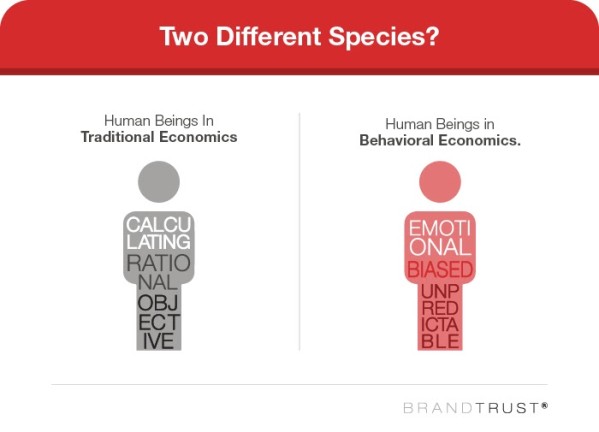
This is, in fact, behavioral economics at work. And, according to Dan Ariely, humans make irrational decisions like this all the time. In fact, he argues in his best-selling book that we are predictably irrational. Understanding our irrationality, and the irrationality of others, is a vital ingredient for solving last-mile barriers to social impact.
Beyond saving money, behavioral economics affects the way people make any decision, from who they love, how they spend time, where they work, and choices they make related to their health. It also helps explain why we have corruption in government, why it is so hard to pull oneself out of poverty, why leaders are not acting with enough urgency to address the climate crisis, and why we have rising inequalities.
Sections II and III will help you think more about how to use the powerful principles of behavioral economics in social impact programs and social entrepreneurial initiatives. But first, let's take a moment to better understand the foundations of behavioral economics.
According to Shahram Heshmat Ph.D., "Behavioral economics attempts to integrate psychologists' understanding of human behavior into economic analysis." This is differs from traditional economics, which has its roots in a rational choice model where a person will weigh the cost and benefit of every decision and then calculate the best choice. The traditional economics model assumes people have perfect self control and are always able to manage emotional reactions. We know, of course, that this is not the case. It's not true for us, and it's not true for people experiencing social, economic, financial, health, or other challenges.
Harvard defines behavioral economics as "variants of traditional economic assumptions (often with a psychological motivation) to explain and predict behavior, and to provide policy prescriptions." The line between these concepts can be blurred, especially when considering things like getting people to take action to address poverty, improve health, or reduce their negative impact on the environment. In reality, for tackling such complex issues, many different schools of thought are needed and there should be an overlap of these different ways of thinking.
Behavioral economics also has close ties to the fields of cognitive and social psychology, and some of the leading thinkers have even switched between these sectors. According to the American Psychological Association, social psychology "is the study of how individuals affect and are affected by other people and by their social and physical environments." Behavioral Economics applies these concepts to the economic decisions that people make, in addition to the rational thinking model. In practice, behavioral economics helps you understand what people actually do in certain situations, and why.
Companies are realizing 'big data' isn't as useful as they were told, and that smaller, precise data sets answer questions quicker and cheaper. (Nextstage Evolution)
In the article Social Psychology v. Behavioral Economics: 3 Key Differences, Alain Samson Ph.D. shares a great visual showing the rapid rise in popularity of behavioral economics since 2008.
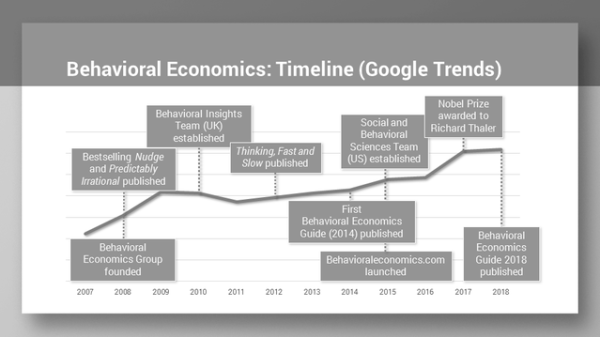
However, the roots of behavioral economics go back much further. In the mid 1700's, Adam Smith hypothesized that humans, or in his words, "homo economicus" make rational economic decisions. However, in his 1759 book, The Theory of Moral Sentiments, he also explains that flawed human psychology affects decision-making. In the 1770's, Benjamin Franklin wrote about more complex decision-making, putting forth a framework for comparing options using "Moral or Prudential Algebra", which is similar to a modern-day pros and cons list. During World War II, traditional economics and "rational decision making" became even more ingrained in the collective culture as it was seen as incredibly helpful in wartime and manufacturing.
Herbet Simon, in 1955, introduced the concept of "bounded rationality" which gave birth to the idea that humans were not consistently rational, but he was ridiculed by his peers for this concept (although later he was awarded a Nobel Prize in economics).. But it wasn't until Amos Tversky and Daniel Kahneman introduced "prospect theory" in 1979 that the field of behavioral economics started to enter more mainstream conversations (they later went on to publish the popular book Thinking, Fast and Slow). In the 1970's and 80's, brain and neuro imaging (using MRI and CT scans) became much more accessible, which led to additional breakthroughs in understanding how humans react in certain situations, and how we understand our brains to work. In 1988, Hersh Shefrin and Richard Thaler (future author of Nudge with Cass Susntein) conducted studies on how behaviors impact economic decisions (like savings), leading to the concept of a "behavior life cycle" in which wealth is assumed to be divided into three mental accounts (current income, current assets, and future income) and our savings decisions depend on the mental category we assign it to. The first behavior economics professor was hired by Harvard in 1994, and in 1999, The Quarterly Journal of Economics dedicated an entire issue to behavioral economics. In 2006, Daniel Gilbert published Stumbling on Happiness, and in 2008, Dan Ariely published Predictably Irrational and Tversky and Kahneman published Thinking Fast and Slow. Later in the year, a popular article was published titled "Only Winner in Madoff's Scheme: Behavioral Economics". In 2010, Chip and Dan Heath published Switch: How to Change Things When Change is Hard which put these concepts into the hands of business leaders and marketers.
From that point, behavioral economics became mainstream, and started to enter into work related to tackling global challenges like healthy democracies, the climate crisis, rising inequalities, and poverty. A 2015 article, "From Economic Man to Behavioral Economics", and another 2017 article in HBR, The Rise of Behavioral Economics and its Influence on Organizations, shows how ingrained these concepts have now become in the landscape of business.
ForeignPolicy.com's article, Anthropology of an Idea: Behavioral Economics, has a nice visual timeline of the progression of behavioral economics, included below:
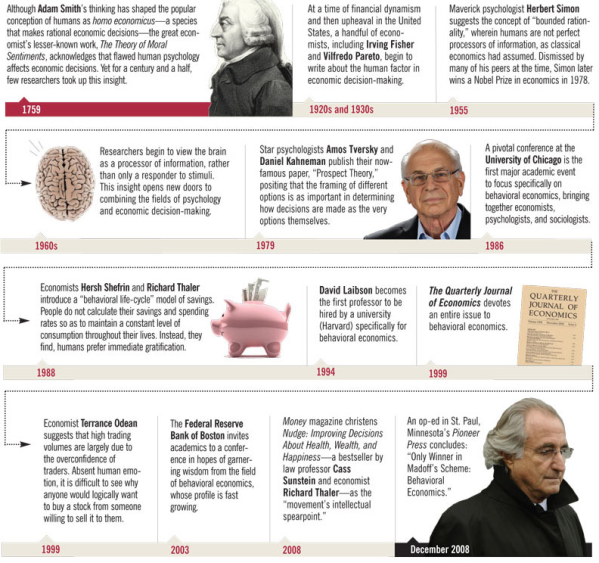
In 2012, Poor Economics: A Radical Rethinking of the Way to Fight Global Poverty and More Than Good Intentions: Improving the Ways the World's Poor Borrow, Save, Farm, Learn, & Stay Healthy brought the ideas of behavioral economics to the social impact sector. Then, in 2015, The Last Mile was published in an effort to explicitly detail connections between specific Behavioral Economics principles and real life examples from social impact practitioners in the field using them to increase the likelihood of their programs success. This great application of behavioral economics for solving real world problems sparked a great amount of discourse as seen in articles like Behavioral Economics in Action: Using Theory to Drive Social Change from Skoll, The New Science of Designing for Humans and How a Nobel Prize in Economics Could Help Solve the Climate Crisis from SSIR, and Applying Behavioral Economics to the Developing World from NextBillion which have since helped educate those working in the sector on important behavioral principles.
In 2019, Esther Duflo and Abhijit Banerjee won the Nobel Prize for their work in Poor Economics, and published a second book, Good Economics for Hard Times which brought the principles of Behavior Economics further to the forefront of social impact work.
Section II: Popular Behavioral Economics Principles
It is true that from a behavioral economics perspective we are fallible, easily confused, not that smart, and often irrational. We are more like Homer Simpson than Superman. So from this perspective it is rather depressing. But at the same time there is also a silver lining. There are free lunches! (Dan Ariely)
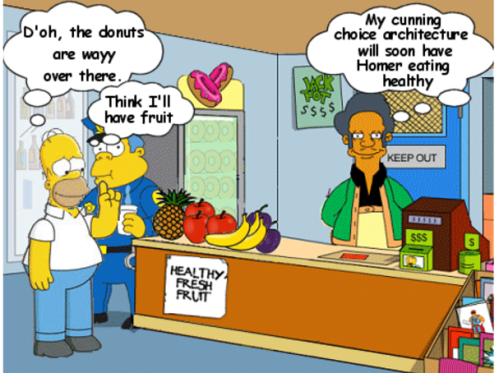
The principles of behavioral economics have certainly become mainstream, and we'll elaborate on these in the section below. Before jumping in, read this article from The Atlantic, The Cognitive Biases Tricking Your Brain, for a great primer on this topic.
Below, you'll find 6 key behavioral economic principles, and the 31 cognitive biases that illustrate those principles at work.

Biases that illustrate this principle include:
- Cashless Effect: People are less likely to cheat with money, but will cheat on value (i.e. people will steal a can of Coke, but not a dollar bill). This also influences why people will pay more for something when cash is not involved (for instance, if they are charging the purchase to a credit card). A scaling social enterprise can use this line of thinking to enable free trials, delayed processing, or other systems to delay the payments in order to increase adoption in early stages.
- Defaulting: People like to "not think" and will choose the easiest option available. As an example, in countries that incorporate organ donation registration into the process of registering for a drivers' license, the opt-in rate is about 80% for countries whose default option for organ donation is "yes". For countries where the default organ donation response is "no" and residents have to check a box or take some other action to opt in, the opt-in rate is only 20%. Scaling social enterprises offering a variety of checkout options can leverage this effect by selecting the option it most wants customers to choose as the default.
- Irrational Value Assessment: People assign value to "irrational" things, like the bottle design or the aesthetic image of the label when evaluating the value of a bottle of wine. This also influences how much value we assign to things we were involved in making (see IKEA effect blow). Scaling social enterprises should remember to pay attention to aesthetic choices, like website design, in addition to the development of the product or solution itself.
- Loss Aversion: People are more motivated by their fear of losing than they are motivated by the possibility of winning. As an example, if someone receives a $200 bottle of wine as a gift, they will experience a marginal increase in satisfaction. If that same bottle slips off the counter and breaks, however, they will experience much more dissatisfaction than the original gain. Adding an expiration date for a free trial is a tactic social enterprises can use to motivate action to be taken during the trial period.
- Optimism Bias: People are more likely to overestimate the probability of positive events. People think that they will be on time. People think that traffic won't be that bad. People think that next year they'll be able to achieve their health goals. Knowing that people are more optimistic about the future than is realistic is an important thing to remember when you get their input on how much they will use a new product or service.
- Peak-End Rule: In thinking about their past experiences, people recall the final and most intense moments of the experience. In one experiment, people had to put their hands in ice water for 30 seconds. A second group put their hands in ice water for 60 seconds, followed by warm water for 30 seconds. The first group rated their experience as worse than the second group, even though they had less time in the painful ice water. A social enterprise that invests in education experiences for beneficiaries, for example, will benefit by ending the experience a fun note so that people leave with a positive association (even if the experience gets off to a shaky start).
- Regret Aversion/Minimization: People will optimize to minimize regret. Instead of considering all options and their likely effects as the basis for a decision, people will instead consider the worst possible outcome (and the regret it would make them feel) and and choose the option that minimizes regret, even if it's not the best option. For a social enterprsie offering a service, including an option that protects the purchase with a fair refund policy can minimize possible regret and motivate that choice to be selected.
- Sunk Cost Fallacy: The more you invest in something, the more likely you are to keep investing in it. As an example, imagine impact investors have invested in social enterprise A. Two years later, this enterprise's growth indicators are not performing as planned. They are considering an investment in another venture, social enterprise B. Even if social enterprise B has more economic potential, they will more likely continue to invest in A because they will be biased by their previous investment. The same bias explains why nonprofits will keep promoting and growing a program, even if those programs are not achieving desired outcomes.
Biases that illustrate this principle include:
- Anchoring and Anchor Pricing: People will create a bias towards the value of a product based on an initial piece of information or reference point. As an example, when Williams Sonoma sold the first ever bread maker, people didn't know if it was a good value or not. As such, they also started selling a premium, commercial quality breadmaker next to the basic model at a much higher price. People could now see what the commercial price was for a breadmaker, and thus perceived the price for the basic one as a better value. Anchoring, combined with framing, can lead people to choose one option over another based on how the options compare.
- Fundamental Attribution Error and the related Self-Serving Bias: People will attribute their successes to their own amazingness, but will attribute others people's successes to luck. People will also attribute their own failures to bad luck, and the failure of other people to their own incompetence. A social enterprise that is struggling to achieve scale might blame this on economic factors, "incompetent partners", or "bad timing". If the same enterprise succeeds, it will attribute its success to its own intelligence and strategy.
- Decoy Effect or Dominated Alternatives: The introduction of a third inferior option will affect how people choose between two options. Let's say you survey a crowd to see if they would rather have: (A) a fully paid trip to Rome, or (B) a fully paid trip to Paris. Let's say more people choose A. Now, let's say you add another option: (C): a fully paid trip to Rome, but with airfare costing extra. In this case, with the introduction of a third inferior option, more people will now choose B than before, because this inferior option makes the comparable option appear more valuable.
- Framing: People's choices are influenced by the words, situations, and/or settings in which they are presented (for example, most people would rather have a surgery presented as having a 90% survival rate vs. the same surgery presented as having a 10% mortality rate). Applying this same logic to a social enterprise raising money for a new program, if it approaches funders with the statistic that the program will save 90% of lives, it will likely raise more money than if it had presented the funders with the statistic that the program will still leave 10% of the population underserved.
- Hot-Cold Empathy Gap: People's decisions are based on their emotions at the time the decision is made. As an example, students taking a class about reproductive health will likely predict that they will make safe choices if asked about it in the classroom, but many of those same students will make different choices than predicted during the classroom "cold state" when in a "hot state" situation, like on a date. This isn't just sexual, i.e. this could include being tempted by unhealthy foods, drinks, drugs, or even inappropriate handling of professional situations.
- Priming: People's behavior will be biased if they are led to consider a specific component of a product before considering the purchase of a product as a whole. As an example, if someone is considering buying two different models of a clean-burning cookstove, if the purchaser is anchored first to something like how much it costs to service, then they will give a greater focus to that component when ultimately making a purchase decision than they otherwise would have.
- Zero-Price Effect: People overreact for free things, and will even expend more resources to acquire something for free (like spending more money on raffle tickets than the prize itself is worth.) The value of it, especially if a user sacrificed to acquire it, will be overestimated, which can make it harder for better solutions to enter the market.
Biases that illustrate this principle include:
- Confirmation Bias: People seek and notice information that reinforces their own existing beliefs. As an example, nonprofit workers serving communities through a religious-based organization may believe that those who don't believe in their god will be punished. When they see people living in poverty who don't share their religious beliefs, that assumption will become further entrenched.
- Decision Fatigue: People have a limited capacity to make decisions, and the more decisions they have to make, the worse the decisions become. As an example, people living in poverty have to make many hard decisions related to day-to-day survival, which impairs their ability to make decisions about other things, like invest in learning, businesses, or other actions without an immediate payoff.
- Hindsight Bias: Upon recalling a historical event, people are likely to assign themselves more intelligence and understanding than they exhibited during the actual event. As an example, business mentors coaching entrepreneurs to learn from their mistakes are likely to encounter a "know it all" mindset, with the entrepreneurs saying things like "I knew it wouldn't work". This, in turn, can make it harder to get to a root cause and coach the entrepreneurs about how to avoid the same mistake in the future.
- Mindless Consumption: People will consume more mindlessly if the item is easily available or if bigger portions are provided. The simple act of removing candy from sight in an office or home and replacing it with fruit will lower the average weight of the people in that environment. As an example, if you're trying to address obesity in a community, the simple act of hiding things people should avoid out of sight and making healthier alternatives visible and available can help improve outcomes.
- Rationalized Dishonesty: People can justify to themselves small actions they know are wrong. They may rationalize that people who commit small acts of cheating, crime, or theft are still good people, though it's important to keep in mind how easily people can slip.
Biases that illustrate this principle include:
- Bandwagon Effect / Herd Mentality: People will start to choose options that are more popular, which in turn reinforces the popularity of those options further. As an example, perhaps a large government of foundation invests money in a certain type of malaria prevention, like bed nets. This option will gain steam and more organizations will spread this approach, even if the data shows that there are more effective preventative measures out there. However, as more organizations join this bandwagon, it continues to reinforce the popularity of this approach.
- Halo and Horns Effect: A person's overall impression of another person or thing impacts how they feel about that person or thing in the long-term. As an example, imagine you are a nonprofit entering a new community in hopes of providing services. If the first impression of your organization is negative - say, you're perceived as arrogant - then even if you show competence, that first impression will last. This counts for both positive and negative perceptions.
- False Consensus: People overestimate how much others agree with them.
- IKEA Effect: People attribute more value to products that they built themselves, than what the market will actually pay. As an example, if you helped build your Ikea shelf, you might think it's now worth $50. However, if you tried to sell it, you could only make $30. We are attached to things we helped make, and therefore engaging customers and beneficiaries in the creation of products and delivery of services will result in them valuing it more highly.
- Pain of Payment or Temporal Discounting: People experience a more acute sense of loss the closer the loss occurs to the payment. For example, if you spend $5 for some fresh fruit and then drop it on the ground and it goes to waste while you are walking out of the store, you will be frustrated and lament your clumsiness. If you spend $5 for some fresh fruit, take it home, forget about it, and then remember it in the bottom drawer of your refrigerator two weeks later only to discover it growing mold, you will not be nearly as frustrated. Why? The further you are away from payment, the less the loss hurts. Temporal discounting is the opposite of this in a way, in that you will take less money today instead of more money in the future.
- Social Norms: Who a person is surrounded by, and how closely they relate to those people, will influence what they do. If your social enterprise introduces a new education program to a community of parents, if they don't see other parents using it they won't use it, either (even if its the superior option.) It's important to note that social norms apply to what people see others do, not what they think others should do. According to Thaler, "The social norms approach states that our behavior is influenced by incorrect perceptions of how other members of our social groups think and act".
- Default to Trust: People are biased to trust those who are like them. As an example, if working with a new partner, that partner will be more likely to trust other existing partners compared to trusting you.
Biases that illustrate this principle include:
- Ambiguity Effect: People will choose known outcomes over uncertainty. For example, people are more likely to choose a product with average online reviews versus a new product with zero reviews.
- Availability Bias: What people are able to recall in recent memory will influence their thinking and memory. Especially in stressed states or when faced with short-term decision making opportunities, people overestimate what they can recall in their memories. Let's say that you're conducting research to see if your social impact intervention is working. You go out to interview your target beneficiaries, and you ask them questions related to their memory, perhaps how often they wash their hands. The availability bias means that they will think about what they did that day, and use that information to inform what their overall trend is, even if it's not actually accurate.
- Illusory Correlation: People often confuse correlation (two things happening at the same time) with causation (one thing causing the other thing to happen.) Just because there are trends in a data set, doesn't mean that one thing caused the other. As an example, imagine that a nonprofit starts working in a community to improve education in inner-city schools, and that they notice a reduction in school drop-out rates. They could claim that their work is the cause for the decrease in dropout rates, but it's possible that it's just correlated to the occurence of their work (perhaps the school district implemented a better after-school program or had increased funding for teacher training.)
- Decision Staging: When people consider options, they will tend to break the decision into stages or elements, and then evaluate individual elements against the same element in the other option. As an example, if a person is deciding where to send their kid to school, they will break the school into elements, like teachers, facilities, location, etc., which they will then compare against the same elements in other schools to help rationalize their decision.
- Prospect Theory: Losses and gains are valued differently, and people will be biased towards sure wins to avoid the pain of possible losses. Some research shows the psychological cost of a loss is twice as powerful as that of a win. For example, if you present someone with the choice between $100 guaranteed or a 50% chance of winning $1,000, most people would choose the first option even though the potential gain is higher in the second..
- Self Handicapping (often connected to self-serving bias): People may withhold effort to avoid risking themselves and damaging their egos. As an example, someone might end up procrastinating studying for an important final exam, so that if they fail, they can blame failure on something other than their inability to do well..
Biases that illustrate this principle include:
- Choice Architechture: Choice architecture is not necessarily ot a principle like the others in this list, but rather a term used to think about how to use behavioral economics when presenting options to people. A person can be a "choice architect" by using behavior economic principles like anchoring, priming, and framing. Yale's 4P framework is a great resource on this topic.
- Dual System Thinking: People's brains have two systems, System 1 and System 2. System 1 is fast, unconscious, automatic, useful for everyday decisions (but also very error prone). System 2 is slow, conscious, effortful, and helpful for making big decisions because its more likely to lead to better outcomes. As an example, a social entrepreneur might yell at a team member for not acting in a way he feels that person should be acting (system 1), but later, while giving advice to another entrepreneur, encourage that person to create a safe environment for all team members to take risks and embrace failure (system two).
- The Elephant, Rider, and Path: This is another way of conceptualizing the way different parts of our brains interact with each other. In this model, people's minds have an elephant (a big, emotional beast that is hard to move), a rider (a rational, forward-looking person), and a path (a way forward that is safe). To move a person you need all three going in the same direction. The riders job is to guide and motivate the elephant down a clear path that the rider agrees is a good idea.
- Nudges: Small influences, or "nudges", will alter how people make choices. Replacing a candy bowl with a fruit bowl is a nudge. Putting your cell phone in another room when you need to concentrate on work is a nudge. Nudges are small changes that make it easy for people to adopt lifestyle choices they want to adopt (or you want them to adopt.)
Section III: Getting Started Using Behavioral Economics for Social Impact
To help you take the first steps in using behavior economics for social impact, we have assembled a few of the leading frameworks that will give you and your organization guidance. In the 2008 book Nudge, authors Richard Thaler and Cass Sunstein label that someone using behavioral economics to help improve outcomes is a "choice architect" -- someone that is making it easier for people to choose to do the thing they want to do.
Implementing Choice Architecture
In Nudge, Thaler and Cass have six principles for good choice architecture, which can be arranged into the mnemonic of NUDGES.
- iNcentives
- Understand mappings
- Defaults
- Give feedback
- Expect error
- Structure complex choices
Designing a Behavioral Nudge
Richard Thaler and Cass Sunstein define a nudge as "any aspect of the choice architecture that alters people's behavior in a predictable way without forbidding any options or significantly changing their economic incentives. To count as a mere nudge, the intervention must be easy and cheap to avoid. Nudges are not mandates. Putting fruit at eye level counts as a nudge. Banning junk food does not."
In order to design an effective nudge, Thaler and Cass give this guidance:
- All nudging should be transparent and never misleading.
- It should be as easy as possible to opt out of the nudge, preferably with as little as one mouse click.
- There should be good reason to believe that the behavior being encouraged will improve the welfare of those being nudged.
- Align incentives with desired behaviors.
- Provide clear, visible, and immediate feedback to reinforce desired actions.
- Simplify and structure choices when decision-making parameters are complex.
- Make goals and performance status clearly visible.
A Framework to Help Change Behavior
In the book Switch: How to Change Things When Change is Hard, the Heath Brothers provide this useful framework to help think about what it takes to change your own behavior, or support others if they are interested in changing their own. They ask you to imagine a person riding an elephant and trying to get it to go somewhere. To do that, you need to:
- Direct the rider | The rider is the rational part of our brains, and uses data and evidence to rationalize a decision.
- Motivate the elephant | The elephant is the emotional (and irrational) part of our brains. It's also the biggest part - it must be emotionally engaged to go in the direction that the rational "rider" wants it to go.
- Shape the path | Make it easy to get from one point to the other by directing the rider and elephant down a clear path.
Helping Ideas Spread
In the book Contagious, Jonah Berger shares the 6 STEPPS to help ideas spread: 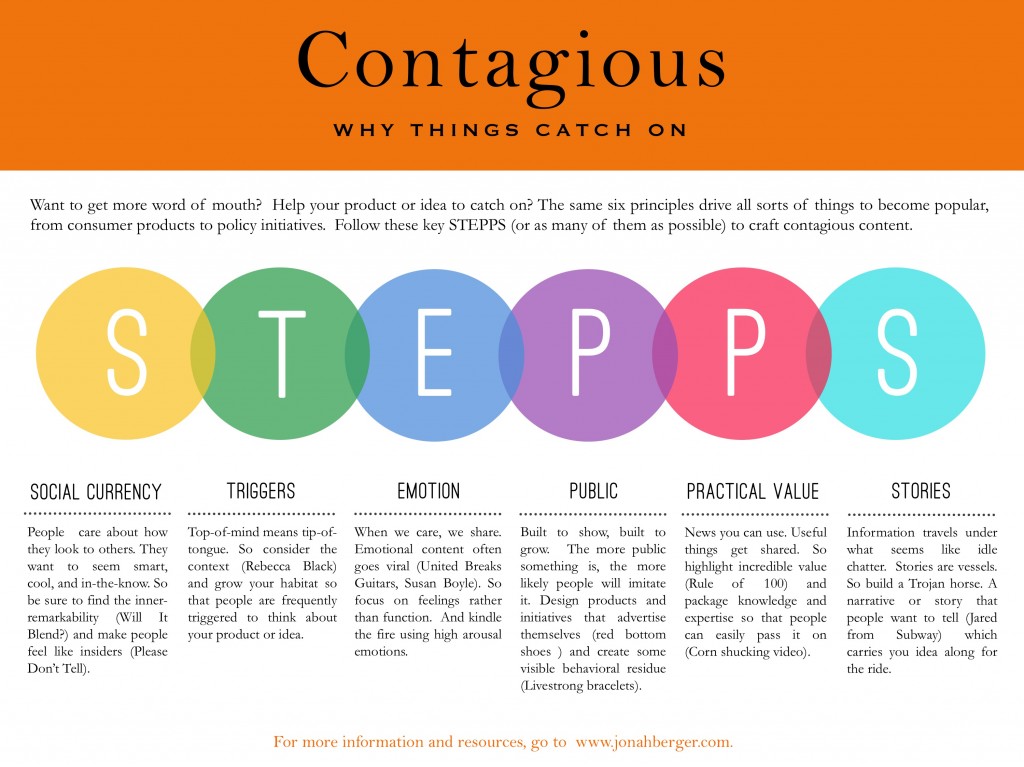
A Process to Design More Effective Behavior Change Interventions
In the book Start at the End (good summary here), Matt Wallaert explains that everything we do is about getting people to change behavior. To do so, he outlines an approach called "Intervention Design Process". It can be summarized to these four stages:
- Identify an insight that recognizes a gap between the world as it is (the real world) and the world as you want it to be (the ideal world).
- Draft a behavioral statement using the template: When (population) (has motivation) and they (meet these limitations) they will (behavior) as measured by (data). As an example, Uber's would be: "When (people) (want to get from Point A to Point B), and they (have a smartphone with connectivity and an electronic form of payment), they will (take an Uber 50% of the time)."
- Map out competing pressures that are facining your population, which are reasons not to do something — inhibitory cues — and reasons to do something — promotion cues.
- Test different inhibitory and promotion cues to help create the desired behavior.
Section IV: Eight Steps to Applying Behavioral Economics to Social Impact
Everyone thinks of changing the world, but no one thinks of changing himself. (Leo Tolstoy)
In the MovingWorlds Institute, we use the term "social enterprise thinking" to define a staged approach to creating sustainable solutions to problems.
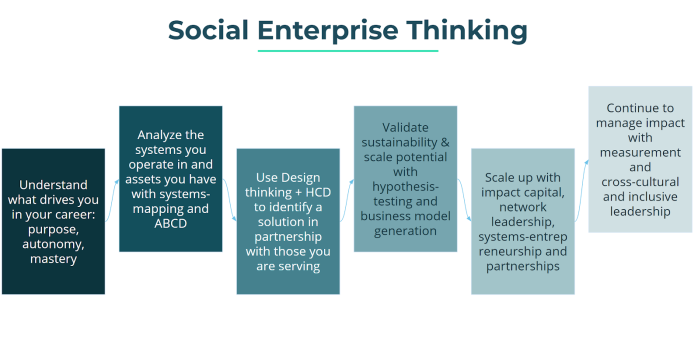
For this guide, we have elaborated on the 6 stages of this process above to include mobilizing support and reviewing ethics, which are very important when seeking to affect behavioral change. This brings us to 8 different stages where behavioral economics principles should be considered when trying to bring about social change:
- Understanding ourselves
- Building teams to do impactful work
- Understanding the people you are seeking to serve
- Developing solutions
- Implementing ideas
- Sustaining and growing social impact programs
- Pushing on systems to start a movement
- Reviewing and considering ethics related to the project
In these 8 stages below, we recommend the most important behavioral economics principles that should be used, as well as some good books, articles, and talks to help you learn more about each phase.
Most people want to change the world to improve their lives, but the world they need to change first is the one inside themselves. (John C. Maxwell)
If you are embarking on a journey to make a positive impact on others, you must start by looking inwards. Our own biases, narratives, and experiences will influence why and how we engage in global development work, and not always for the better.
Taking time to explore what motivations we have for engaging in social impact work is a necessary first step to prevent ego-driven projects that benefit the wrong populations. How do you explore yourself using principles of behavioral economics?
Key behavioral economic principles (defined above) that will be helpful to look more deeply at in this stage:
- Your own optimism bias might trick you into thinking that success is guaranteed, creating blind spots in terms of contingency planning or thinking through complex details.
- Chances are, confirmation bias will also lead you to seek out information that confirms your existing world-view, rather than challenging it.
- Social norms are also likely to influence the way you approach creating a positive impact, but keep in mind that just because people around you engage in a certain way doesn't mean it's the best way (this guide can help you learn the most ethical and sustainable way to engage in impact work.)
To better understand yourself, and how your motivations will influence the work you do to create social impact, consider the following resources:
- Read: Stumbling on Happiness by Dan Gilbert (good summary here) and Originals: How Non-Conformists Move the World by Adam Grant (good summary here)
- Watch: Our Buggy Moral Code TED Talk by Dan Ariely
- Skim: What Motivates People to Participate in Civil Society? in SSIR
- Get Inspired: What Motivates the Best Social Entrepreneurs? by Northeastern University
Social impact projects inherently require a diverse set of organizations and individuals to come together. With the growth of systems entrepreneurship and network leadership, this trend will only continue. As a leader or contributor of a team, applying behavioral economics principles can help you and your team perform at your best.
Key behavioral economic principles (defined above) that will be helpful to you at this stage:
- Remember that when you start working with others, they have dual systems: one emotional, irrational system that will react quickly, and one more rational system that thinks through things slowly and methodically. When building teams, you need to make sure that you build trust quickly, and to do that, you'll need to speak to both systems from the beginning
- The bandwagon effect will make it easier to garner more support once you build up momentum by getting key stakeholders on board… or can make it harder if people are irrationally heading to other networks that are popular, despite not being effective.
- Decision framing can influence whether or not people are willing to join your team or effort, so be sure to present the choice with carefully chosen words and in the right setting. Catching someone on their way out the door is definitely not the best time to make the ask!
To better understand how to build the best team to create social impact, consider these following resources:
- Read: Thinking, Fast and Slow (good summary here) and More Than Good Intentions: Improving the Ways the World's Poor Borrow, Save, Farm, Learn, & Stay Healthy (good summary here)
- Watch: Start With Why: How Great Leaders Inspire Action TED Talk by Simon Sinek
- Skim: The New Network Leader in SSIR
- Get inspired: A Network Approach to a No-Kill Nation
Before starting any project, it's important to take time to understand the current state of the system you want to operate in and the problem you want to address. We think that frameworks like Asset Based Community Development (ABCD), Systems Mapping, and Human-Centered Design are particularly helpful in understanding the current state of things. However, in the act of research and discovery, you'll want to consider how behavioral economics can influence behavior.
Key behavioral economic principles (defined above) that will be helpful to consider at this stage:
- Considering the empathy gap that may exist between the state people are in during user discovery interviews and the state they will be in at the time that you are looking to support them
- Avoiding decision fatigue by limiting how many choices people have to make, and its effects on rationality in the moment
- Considering how loss aversion and regret minimization might influence your target beneficiaries to make different choices than the ones you predict
- Ensuring that you and your organization make a good first impression so that the halo and horns effect leaves people with a positive long-term view that will make your work easier, rather than harder.
To better understand how to really get to know the people you are serving with behavioral economics, consider the following resources:
- Read: Poor Economics: A Radical Rethinking of the Way to Fight Global Poverty, Freakonomics, and Switch: How to Change Things When Change is Hard
- Watch: How to Make Choosing Easier TED Talk by Sheena Iyengar, Choice, Happiness, & Spaghetti Sauce TED Talk by Malcom Gladwell, and Why People Believe Weird Things TED Talk by Michael Shermer
- Skim: A Nobel Prize Winner on Rethinking Poverty (and Business) in HBR
- Get inspired: The CLTS Approach
As you work towards developing programs, products, services and/or other solutions that have a positive social impact, you should use a human-centered design process. Going through this process creates many opportunities for you to use behavioral economics principles, and test different approaches to see what the market really responds to.
Key behavioral economic principles (defined above) that will be helpful to you at this stage:
- The IKEA effect will mean that once you, or others you work with, come up with ideas, you will overvalue them compared to others. Don't get biased! Work with your target beneficiaries to co-develop a solution that specifically meets their needs that they will also feel a sense of ownership over.
- Attribution theory can lead you to be overconfident that your own influence in the process is more important than it really is. You should strive to remove your own ego from the process - fall in love with the problem, not your solution.
- Avoid a false consensus by gathering quantitative data about how potential users feel about the solution being developed so that you don't overestimate how much others agree with your solution as a good idea.
- Remember that defaulting means that people will typically take the path of least resistance, so make it easy for them to adopt your solution without having to jump through multiple hoops.
- Social norms will greatly affect what is adopted, and what isn't, so make sure you're engaging key stakeholders in the community and earning their confidence in the value of your solution
To better understand how to apply behavioral economics to develop solutions that work, consider the following resources:
- Read: The Last Mile (good summary here), Start at the End (good summary here) and Barking Up the Wrong Tree (good summary here)
- Watch: How Behavioral Economics Can Creatively Solve Business Problems lecture by Rory Sutherland and Are We In Control of Our Own Decisions TED Talk by Dan Ariely
- Skim: Do Economists Underestimate the Impact of Social Factors on Behaviour? on WeForum and Applying Behavioral Economics Toward Social Change on Medium
- Get Inspired: How Behavioral Economics Can Produce Better Healthcare
As you and your partners continue your work, you'll eventually reach the point in the human-centered design process where it's time to start implementing and testing ideas. It's important to avoid letting false positives derail your work. A solution might seem to work, only to fall apart shortly after, or a solution might fail a specific experiment, but actually be the right solution in the end.
Key behavioral economic principles (defined above) that will be helpful to consider at this stage:
- Irrational value assessment means that initial valuations of your products may be irrational - you might end up with false indicators based on "irrational" factors like aesthetic, so engage in A/B testing to isolate those factors
- Don't let confirmation bias lead you to only seek out information that reinforces your assumptions, or you'll ignore flags hat you should really be paying attention to
- Self-handicapping means that you, your team members, and/or beneficiaries might start to progress in the right direction, but then self-sabotage that progress due to feelings of vulnerability or threats to ego.
- Remember that loss aversion makes people scared to lose, so if your solution requires a change or switching from the familiar to the unfamiliar, your target audience will likely immediately be skeptical and you will need more resources than you are counting on in order to be effective
- To get ideas to stick, you'll need to address the elephant, the rider, and the path.
- Consider nudges that make your solution easier to adopt, particularly in the last-mile.
- Continuously test your plan and assumptions against reality and facts to avoid a false-consensus in which you think people share the same understanding and beliefs that you do, when in reality they are more different then you realize.
To better understand how to implement solutions that create real social impact, consider the following resources:
- Read: The Last Mile (good summary here), Nudge (good summary here), and The Power of Moments (good summary here)
- Watch: Social Experiments to Fight Poverty TED Talk by Esther Duflo
- Skim: Behavioral Economics in Action: Using Theory to Drive Social Change in SSIR and The Rise of Behavioral Economics and its Influence on Organizations in HBR
- Get inspired: Nudging for Good case studies
Once a program is implemented, you must continue to invest in the programs adhesion and ongoing improvement. This includes things like measuring success, getting real input from users about how to improve, and continuing to optimize the program for better outcomes.
Key behavioral economic principles (defined above) that will be helpful to consider at this stage:
- Keep in mind that the information you collect may be subject to availability bias, which gives more weight to recent experiences
- Use choice architecture and concepts like anchoring, priming, and framing to experiment with different ways you can present the solution to drive the outcomes you're striving for.
- Never stop learning from your mistakes, and don't let hindsight bias lead you to give yourself more credit than you deserve for recognizing shortcomings in your work so far.
- Nudges, like with the step before, will be important to keep optimizing for the desired behavioral change to gain adoption.
- Pain of payment and temporal discounting affect how people will adopt (and keep adopting) based on if people have to pay for the intervention, and experimenting with the method and timing of payment can help you optimize outcomes.
- If your program ultimately isn't going to work long-term, don't let the sunk cost fallacy lead you to continue to invest in it
To better understand what it takes to get ideas to scale, here are some extra resources for you:
- Read: The Last Mile (good summary here), Made to Stick (good summary here) and Good Economics for Hard Times (good summary here)
- Watch: The Paradox of Choice TED Talk by Barry Schwartz and Why Dieting Usually Doesn't Work by Sandra Aamodt
- Skim: When Social Impact Meets Behavioral Economics on Hackernoon and How to Build Better Calls to Action in SSIR
- Get inspired: Behavioral Economics in Action: Using Theory to Drive Social Change
The true measure of the success of a social enterprise is whether it exerts pressure to make the systems around it better. To help your solution or initiative gain the traction it needs to inspire others to change, keep the following behavioral economic principles related to movement-building in mind:
- The bandwagon effect / herd mentality tells you that if you can build enough support, that support will keep building on itself
- Decision staging will help you illustrate the differences (and hopefully advantages) of your movement or approach against others
- Anchoring can help you position your movement against others by sharing the most important information first
- Priming people to consider a specific component of your solution first will help you gain widespread interest
To better understand how to use behavioral economics to turn your solution or initiative into a broader movement, consider these following resources:
- Read: The Tipping Point: How Little Things Can Make a Big Difference (good summary here) and When: The Scientific Secrets of Perfect Timing (good summary here)
- Watch: The Riddle of Experience vs. Memory TED Talk by Daniel Kahneman
- Skim: The 3.5% Rule: How a Small Minority Can Change the World from BBC
- Get inspired: Knowing when to Nudge
Section V: The Best Books, Videos, Blogs, and Infographics to Learn More About Behavioral Economics
Must-read books about behavioral economics and social impact
- Atomic Habits: An Easy & Proven Way to Build Good Habits & Break Bad Ones , by James Clear.
- Barking Up the Wrong Tree: The Surprising Science Behind Why Everything You Know About Success Is (Mostly) Wrong, by Eric Barker.
- Blink: The power of thinking without thinking, by Malcolm Gladwell.
- Contagious: Why Things Catch On, by Jonah Berger.
- Everything Is Obvious: *Once You Know the Answer, by Duncan J. Watts.
- Freakonomics, by Steven Levitt and Stephen Dubner.
- Good Economics for Hard Times, by Abhijit V. Banerjee and Esther Duflo.
- How Change Happens, by Cass R. Sunstein.
- Influence: The Psychology of Persuasion, by Robert B. Cialdini .
- Irrational Exuberance, 3rd addition, by Robert Shiller.
- Made to Stick: Why Some Ideas Survive and Others Die, by Chip and Dan Heath.
- Misbehaving: The Making of Behavioral Economics, by Richard Thaler.
- More Than Good Intentions: Improving the Ways the World's Poor Borrow, Save, Farm, Learn, and Stay Healthy , by Dean Karlan.
- Nudge: Improving Decisions About Health, Wealth, and Happiness, by Richard Thaler and Cass Sunstein.
- Originals: How Non-Conformists Move the World, by Adam Grant.
- Poor Economics: A Radical Rethinking of the Way to Fight Global Poverty , by Abhijit V. Banerjee and Esther Duflo.
- Predictably Irrational, Revised and Expanded Edition: The Hidden Forces That Shape Our Decisions, by Dan Ariely.
- Redirect: Changing the Stories We Live By, by Timothy Wilson.
- Sidetracked: Why Our Decisions Get Derailed, and How We Can Stick to the Plan, by Francesca Gino.
- Small Is Beautiful: Economics as if People Mattered, by E. F. Schumacher.
- Start at the End: How to Build Products That Create Change, by Matt Wallaert.
- Stumbling on Happiness, by Dan Gilbert.
- Switch: How to Change Things When Change Is Hard , by Chip and Dan Heath.
- Talking to Strangers: What We Should Know about the People We Don't Know , by Malcolm Gladwell.
- The Honest Truth About Dishonesty: How We Lie to Everyone--Especially Ourselves, by Dan Ariely.
- The Last Mile: Creating Social and Economic Value from Behavioral Insights, by Dilip Soman.
- The Paradox of Choice: Why More Is Less, by Barry Schwartz.
- The Power of Moments: Why Certain Experiences Have Extraordinary Impact, by Chip and Dan Heath.
- The Power of Positive Deviance: How Unlikely Innovators Solve the World's Toughest Problems, by Richard Pascale, Jerry Sternin, and Monique Sternin.
- The Tipping Point: How Little Things Can Make a Big Difference , by Malcolm Gladwell.
- The Upside of Irrationality: The Unexpected Benefits of Defying Logic at Work and at Home Kindle, by Dan Ariely.
- Think Twice: Harnessing the Power of Counterintuition, by Michael Mauboussin .
- Thinking, Fast and Slow, by Daniel Kahneman .
- Scarcity: Why Having Too Little Means So Much, by Eldar Shafir and Sendhil Mullainathan.
- When: The Scientific Secrets of Perfect Timing , by Dan Pink.
Our all-time favorite behavioral economics blogs
- Brain Pickings
- Wait But Why
- Freakonomics Blog (and a great podcast, too)
- Dan Ariely's Blog
- Behavioral Insights Team Blog
- The Undercover Economist Blog by Tim Hartford
- The Center for Advanced Hindsight Blog
- The Nudge Blog
- The Decision Lab Blog
- Psychology Today
- Behavioral Economics Blog
- Behavioral Scientist Blog
Best behavioral economics podcasts
- Hidden Brain
- Freakonomics podcast
- Invisibilia
- 2 Guys on Your Head
- You Are Not So Smart
- The Brainy Business
Our favorite videos, talks, and lectures about behavioral economics
- What Makes Us Feel Good About Our Work TED Talk by Dan Ariely
- The Surprising Science of Happiness TED Talk by Dan Gilbert
- Are We In Control of Our Own Decisions? TED Talk by Dan Ariely
- Our Buggy Moral Code TED Talk by Dan Ariely
- The Psychology of Your Future Self TED Talk by Dan Gilbert
- How to Make Choosing Easier TED Talk by Sheena Iyengar
- Choice, Happiness, & Spaghetti Sauce TED Talk by Malcom Gladwell
- Why People Believe Weird Things TED Talk by Michael Shermer
- The Art of Misdirection TED Talk by Apollo Robbins
- 3 Clues to Understanding Your Brain TED Talk by Vilayanur Ramachandran
- The State of Psychology TED Talk by Martin Seligman
- Don't Regret Regret TED Talk by Kathryn Schulz
- Why You Will Fail to Have a Great Career TED Talk by Larry Smith
- Why Dieting Doesn't Usually Work TED Talk by Sandra Aamodt
- The Paradox of Choice TED Talk by Barry Schwartz
- Simplifying Complexity TED Talk by Eric Berlow
- How Great Leaders Inspire Action TED Talk by Simon Sinek
- What We Think We Know TED Talk by Jonathan Drori
- The Power of Vulnerability TED Talk by Brene Brown
- Why We Make Bad Decisions TED Talk by Dan Gilbert
- Why We Do What We Do TED Talk by Tony Robbins
- Living and Working With Childlike Wonder TEDx Talk by Liz Wizeman
- The Surprising Habits of Original Thinkers TED Talk by Adam Grant
- The Riddle of Experience vs. Memory TED Talk by Daniel Kahneman
- Behavioral Economics TEDx Talk by Julia Dupire
- How Behavioral Economics Can Creatively Solve Business Problems lecture by Rory Sutherland
- How to Make a Behavior Addictive TEDx Talk by Zoë Chance
- Explorations of the Mind: Intuition lecture by Daniel Kahneman
- 5 Best Practice Behavioral Economics Strategies lecture by Nick Southgate
Infographics to help you understand behavioral economics in context
What is behavioral economics? infographic from B2B International 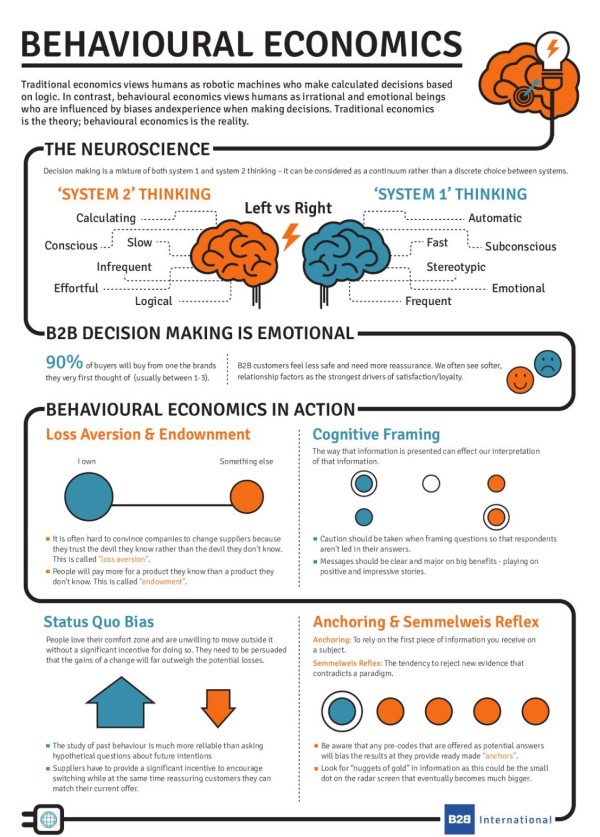
Yale's 4-P's Framework on choice architecture and influence 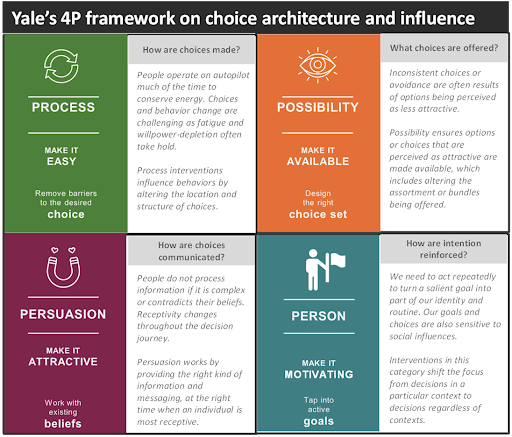
The Mindspace Framework from the BearingPoint Institute 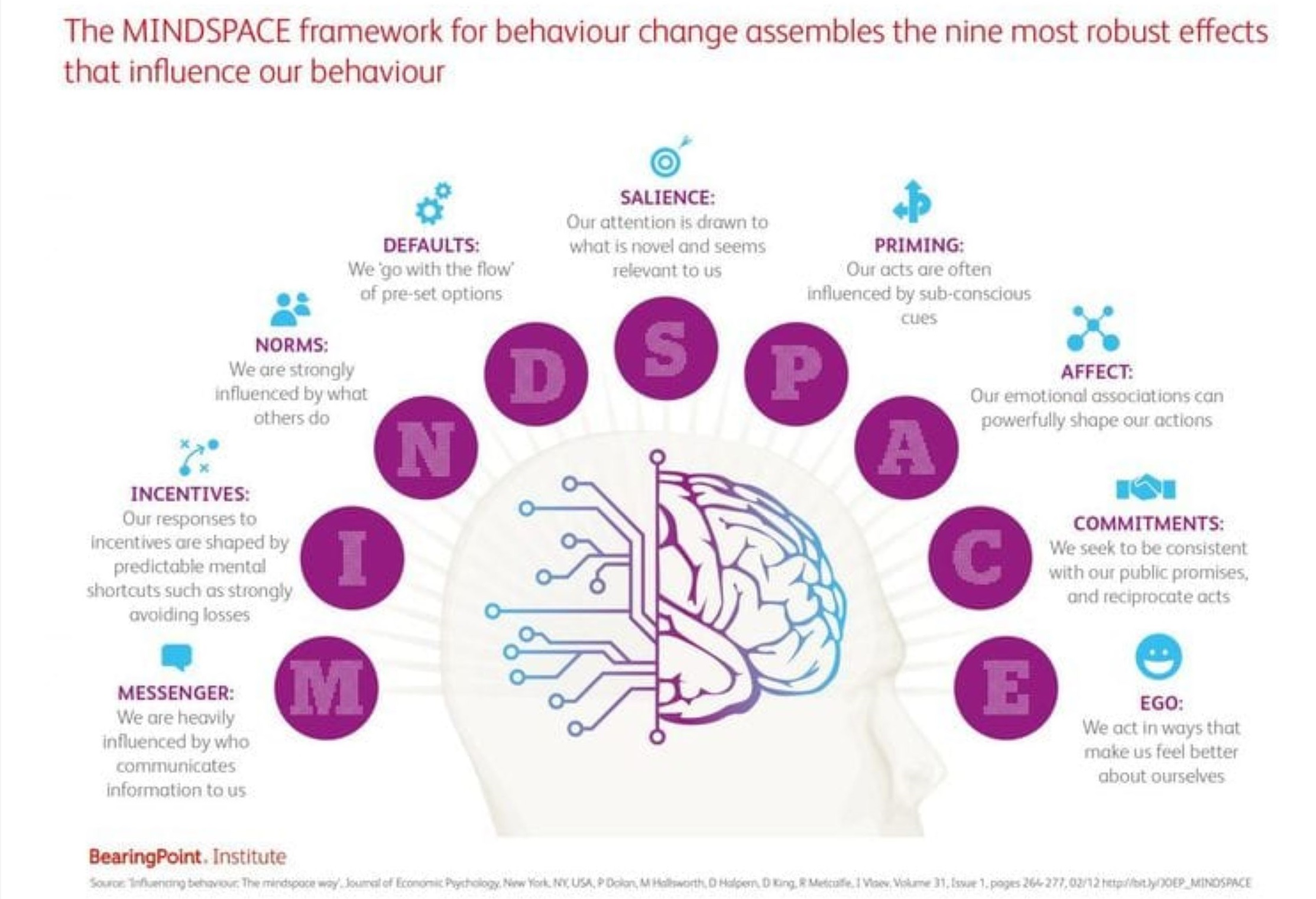
The Cognitive Bias Codex from Better Humans 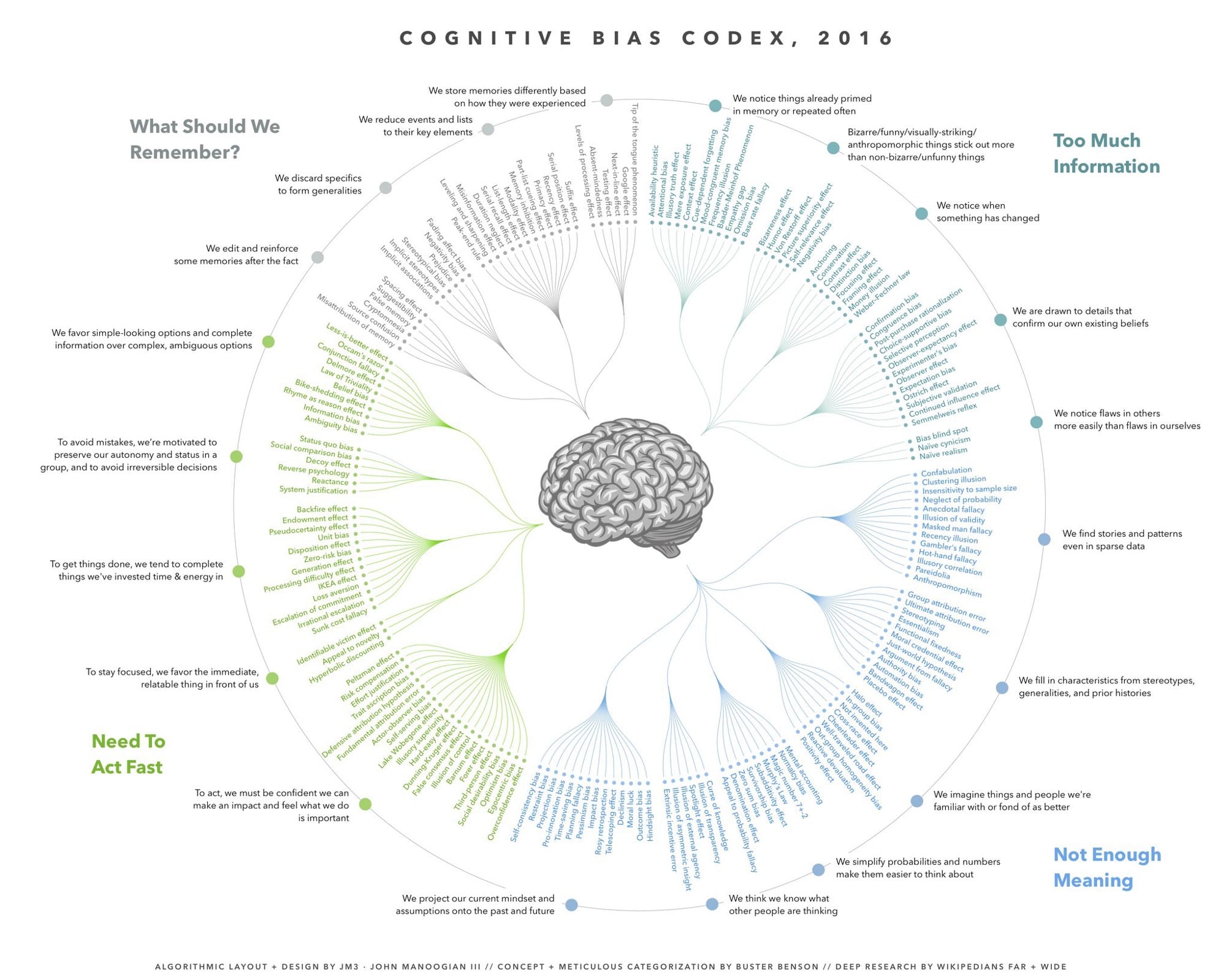
Ethical considerations for using nudges from the UCD Geary Institute for Public Policy's Nudge 'FORGOOD' framework 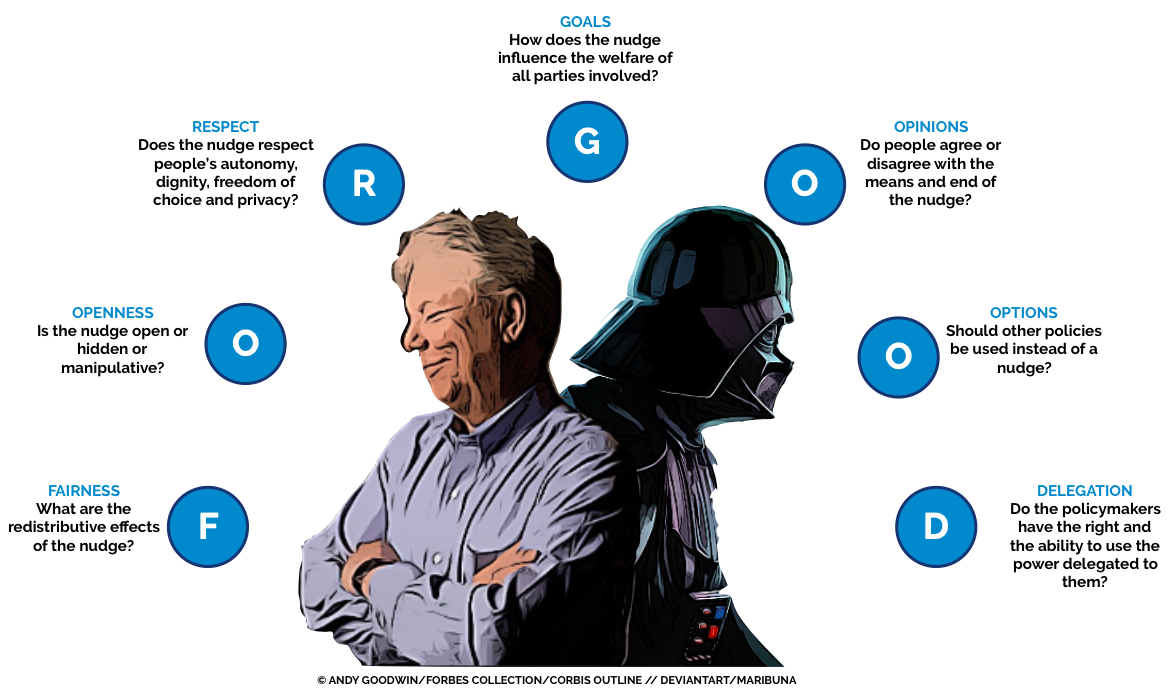
Dan Ariely In Designing Persuasive Behavioral Finance Tools
Source: https://movingworlds.org/behavioral-economics-for-social-impact
Posted by: oharacompay.blogspot.com

0 Response to "Dan Ariely In Designing Persuasive Behavioral Finance Tools"
Post a Comment